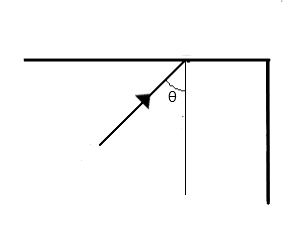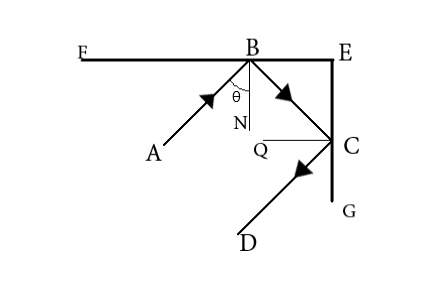Question
Question: Two plane mirrors arranged at right angles to each other as shown in figure A. A ray of light is inc...
Two plane mirrors arranged at right angles to each other as shown in figure A. A ray of light is incident on the horizontal mirror at an angle θ, for what value of θ the ray emerges parallel to the incoming ray after reflection from the vertical mirror.

(A) 60∘
(B) 30∘
(C) 45∘
(D) All of these
Solution
Hint
For parallel emergent ray, the angle which the incident ray makes with the vertical (normal of horizontal mirror) must be equal to the angle of which the emergent ray (second reflected ray) makes with the vertical (surface of second mirror). Angle of reflection is equal to angle of incidence. So by using this we can calculate the answer.
Formula used: In the solution we will be using the following formula,
⇒θi=θr where θi is the angle of incidence and θr is the angle of reflection from a plane mirror.
Complete step by step answer
In the question we are given the incident ray in the diagram. So on completing the figure we get,

The incoming incident ray AB has an angle θi. After reflection, the law of reflection dictates that the reflected ray BC has an angle of reflection equal to the angle of incidence.
Hence from diagram angle ∠NBC=∠ABN=θi.
Thus, in general, angle ∠ABC=θi+θi=2θi.
From a rule of geometry, alternate angles are equal. Therefore, the angles ∠BCE and ∠NBC are alternate angles so we can write,
⇒∠BCE=∠NBC
Since ∠NBC=θi then we get ∠BCE=θi
The line QC is the normal of the mirror EG, hence angle ∠QCE=90∘
Then ∠BCQ=90∘−∠BCE.
Replacing ∠BCE=θi into equation above, we have that
⇒∠BCQ=90∘−θi=α
Now, we see that the line BC which is the reflected ray of mirror FE is the incident ray of mirror EG. Hence, ∠BCQ=α is the angle of incidence of mirror EG.
Also, in a vertical plane mirror, the angle of incidence is equal to the angle of reflection.
Hence,
⇒∠QCD=α
Then, in total,
⇒∠BCD=α+α=2α
Line ECG can be regarded as an angle on a straight line which is equal to 180∘
Hence, angle ∠DCG=180−2α−θi=180−2(90−θi)−θi
Evaluating, we have the value as,
⇒∠DCG=180−180+2θi−θi
So we get,
⇒∠DCG=θi
We see that irrespective of incident angle θi the emergent ray always makes the same angle θi with the vertical. Hence, AB is parallel to DC irrespective of angle of incidence.
Thus, the correct option is (D).
Note
A common error is for students to think that because ray AB is parallel to ray DC, the shape ABCD must be part of a rectangle. However, this is erroneous. To circumvent such error, we need to think as follows: if angle θi is, say 60∘ the angle of reflection is also 60∘, then angle ∠ABC=120∘ but a corner of a rectangle is equal to 90∘, hence line ABCD must not always be a rectangle.
